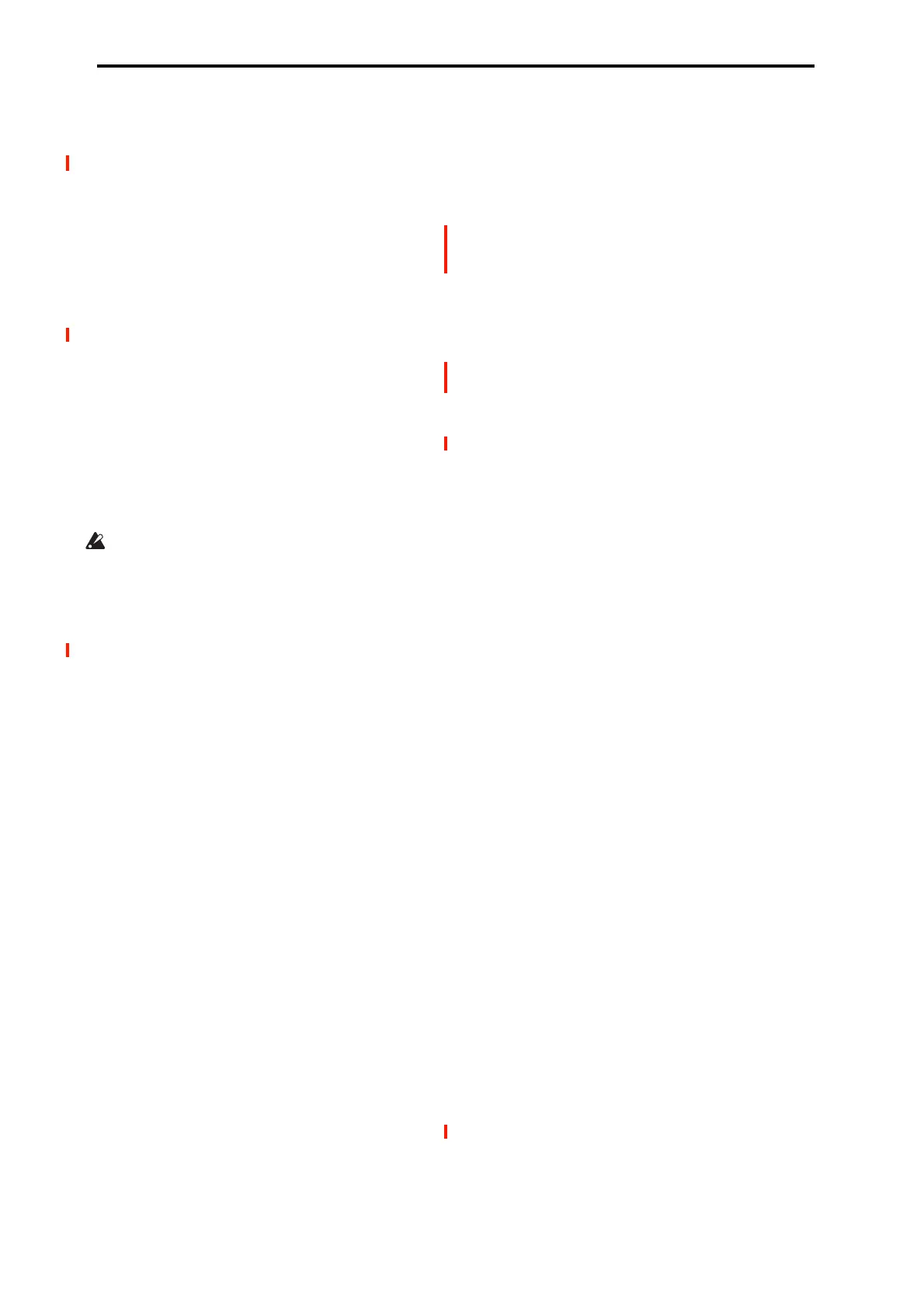SAMPLING mode
578
Stereo: The L and R channels of the Source Bus will be
sampled in stereo, creating a stereo multisample.
Sample Time [min] [sec]
Specifies the amount of time that you wish to sample, in
0.001 second increments.
Immediately after the power is turned on, this parameter
indicates amount of remaining RAM memory in the selected
memory bank (the available sampling time). If you record a
sample in this condition, the change in time will be displayed
automatically.
If Save to is set to DISK, the maximum value is calculated
from the amount of remaining space on the selected drive.
Tips: If you have sufficient RAM memory, it is a good idea
to set an ample “Sample Time,” and to use the “Truncate (for
Sample Edit),” “Truncate (for Loop Edit)” page menu
command after you sample to delete unwanted portions of
the sample and reduce it to the minimum size necessary. You
can also press the SAMPLING START/STOP button to
manually stop sampling after you have recorded the desired
material.
For more details on sampling please see “Sampling (Open
Sampling System)” on page 121 of the OG.
If Save to is set to RAM, and you continue sampling with
Auto Optimize RAM disabled, wasted space will
develop in memory, decreasing the amount of available
RAM. In this case, use the Optimize RAM command to
recover the wasted space. For more information, see
“Optimize RAM” on page 610.
Note: “Free Sample Memory/Locations” (0–1f) lets you
check the remaining amount of RAM.
The remaining amount of memory will depend on the
following conditions:
• The amount of memory that is installed.
• The size of any loaded EXs samples.
• Whether sampling in stereo or in mono. If Mode (0–1d)
is set to Stereo, the maximum “Sample Time” will be
halved.
• The time specified for “Pre Trigger REC” (0–8c: a
function that automatically samples the sound even
before you begin sampling) will be subtracted from the
amount of memory that actually remains.
Auto Loop On [Off, On]
On (checked): Looping will automatically be enabled for
newly recorded samples. For more information, see “Loop
(Loop On)” on page 590.
Auto +12dB On [Off, On]
On playback, samples are normally reduced in volume by
12dB, to reduce the chance of clipping when playing many
voices simultaneously. This parameter lets you defeat the
volume reduction for individual samples, when desired.
In general, +12dB should be On for drums and loops (so that
they play at the same level as they were recorded), and Off
for any sounds that you play polyphonically. For more
information, see “+12dB” on page 590.
On (checked): +12dB will automatically be enabled for
newly recorded samples.
Off (unchecked): +12dB will not be enabled for newly
recorded samples. You can still enable it manually for
individual samples as desired, at any time. This is the default
setting.
This setting applies only when Save to is set to RAM. It
does not apply if Save to is set to DISK.
Note: Auto +12 dB On is set separately for each mode:
PROGRAM, COMBINATION, SEQUENCER, and
SAMPLING. In SAMPLING mode, Auto +12 dB On is
disabled by default.
Sample to Disk [16-bit, 24-bit]
This sets the bit depth for sampling to disk. Note that this
does not affect sampling to RAM. This same parameter
appears on the sampling setup pages in PROGRAM,
COMBINATION, SEQUENCER, and SAMPLING modes;
changes in one place are reflected everywhere.
The resulting 24-bit files can be used at full resolution in
audio tracks. When loaded into SAMPLING mode, they are
automatically converted to 16-bit data.
Sampling examples
Example: Sampling a mono source connected to
AUDIO INPUT 1
If using the Audio Input:
Source Bus: Audio Input 1/2 (0–8c)
Resample: Manual (0–8c)
Recording Level [dB]: as desired (0–1c)
Mode: L-Mono (0–1d)
(→ see diagram in 0–8c: Source Bus = Audio Input 1/2)
If using the L/R Bus:
Input1 Bus Select (IFX/Indiv.): L/R (0–8a)
Input1 Pan: L000 (0–8a)
Input1 Level: 127 (0–8a)
Source Bus: L/R (0–8c)
Resample: Manual (0–8c)
Recording Level [dB]: as desired (0–1c)
Mode: L–Mono (0–1d)
(→ see diagram in 0–8c: Source Bus = L/R)
Example: Sampling a mono input, with internal
stereo effects
Here, we’ll apply the internal insert effect 101: Reverb Hall
to a mono source connected to AUDIO INPUT 1, and then
sample in stereo.
Input1 Bus Select (IFX/Indiv.): IFX1 (0–8a)
Input1 Pan: C064 (0–8a)
Input1 Level: 127 (0–8a)
Source Bus: L/R (0–8c)
Resample: Manual (0–8c)
IFX1: select 101: Reverb Hall (IFX– Insert FX page)
Recording Level [dB]: as desired (0–1c)
Mode: Stereo (0–1d)
(→ see diagram in 0–8c: Source Bus = L/R)

